Diatomite and Glucose Bioresources Jointly Synthesizing Anode/Cathode Materials for Lithium-Ion Batteries
Abstract
1. Introduction
2. Materials and Methods
2.1. Fabrication of Cathode Electrode Li2MnSiO4/C
2.2. Fabrication of Anode Electrode Si/C
2.3. Fabrication of Coin Batteries
3. Results and Discussion
3.1. Morphology Characteristics
3.2. Structural Characteristics
3.3. Electrochemical Performance
4. Conclusions
Author Contributions
Funding
Institutional Review Board Statement
Informed Consent Statement
Data Availability Statement
Conflicts of Interest
References
- Duffner, F.; Kronemeyer, N.; Tübke, J.; Leker, J.; Winter, M.; Schmuch, R. Post-lithium-ion battery cell production and its compatibility with lithium-ion cell production infrastructure. Nat. Energy 2021, 6, 123–134. [Google Scholar] [CrossRef]
- Xiong, R.; Pan, Y.; Shen, W.; Li, H.; Sun, F. Lithium-ion battery aging mechanisms and diagnosis method for automotive applications: Recent advances and perspectives. Renew. Sustain. Energy Rev. 2020, 131, 110048. [Google Scholar] [CrossRef]
- Sasrimuang, S.; Chuchuen, O.; Artnaseaw, A. Synthesis, characterization, and electrochemical properties of carbon nanotubes used as cathode materials for Al–air batteries from a renewable source of water hyacinth. Green Process. Synth. 2020, 9, 340–348. [Google Scholar] [CrossRef]
- Lyu, P.; Liu, X.; Qu, J.; Zhao, J.; Huo, Y.; Qu, Z.; Rao, Z. Recent advances of thermal safety of lithium ion battery for energy storage. Energy Storage Mater. 2020, 31, 195–220. [Google Scholar] [CrossRef]
- Pushnitsa, K.; Kosenko, A.; Chernyavsky, V.; Pavlovskii, A.A.; Novikov, P.; Popovich, A.A. Copper-Coated Graphite Felt as Current Collector for Li-Ion Batteries. Coatings 2022, 12, 1321. [Google Scholar] [CrossRef]
- Sommerville, R.; Zhu, P.; Rajaeifar, M.A.; Heidrich, O.; Goodship, V.; Kendrick, E. A qualitative assessment of lithium ion battery recycling processes. Resour. Conserv. Recycl. 2021, 165, 105219. [Google Scholar] [CrossRef]
- Liu, K.; Wei, Z.; Yang, Z.; Li, K. Mass load prediction for lithium-ion battery electrode clean production: A machine learning approach. J. Clean. Prod. 2021, 289, 125159. [Google Scholar] [CrossRef]
- Chen, Y.; Liu, H.; Jiang, B.; Zhao, Y.; Meng, X.; Ma, T. Hierarchical porous architectures derived from low-cost biomass equisetum arvense as a promising anode material for lithium-ion batteries. J. Mol. Struct. 2020, 1221, 128794. [Google Scholar] [CrossRef]
- Zhang, Y.; Zhang, R.; Chen, S.; Gao, H.; Li, M.; Song, X.; Xin, H.L.; Chen, Z. Diatomite-Derived Hierarchical Porous Crystalline-AmorphousNetwork for High-Performance and Sustainable Si Anodes. Adv. Funct. Mater. 2020, 30, 2005956. [Google Scholar] [CrossRef]
- Wu, W.; Wang, M.; Wang, J.; Wang, C.; Deng, Y. Green Design of Si/SiO2/C Composites as High-Performance Anodes for Lithium-Ion Batteries. ACS Appl. Energy Mater. 2020, 3, 3884–3892. [Google Scholar] [CrossRef]
- Shibutani, N.; Sugiura, K.; Tanaka, A.; Nagato, K. Examination on Water Management Method in the Same Electrode in PEFC. ECS Trans. 2021, 104, 243. [Google Scholar] [CrossRef]
- Ribeiro, M.J.; Tulyaganov, D.U.; Ferreira, J.M.F.; Labrincha, J.A. Production of Al-rich sludge-containing ceramic bodies by different shaping techniques. J. Mater. Process. Technol. 2004, 148, 139–146. [Google Scholar] [CrossRef]
- Nie, W.; Cheng, H.; Liu, X.; Sun, Q.; Tian, F.; Yao, W.; Liang, S.; Lu, X.; Zhou, J. Surface organic nitrogen-doping disordered biomass carbon materials with superior cycle stability in the sodium-ion batteries. J. Power Sources 2022, 522, 230994. [Google Scholar] [CrossRef]
- Dominko, R.; Bele, M.; Gaberšček, M.; Meden, A.; Remškar, M.; Jamnik, J. Structure and electrochemical performance of Li2MnSiO4 and Li2FeSiO4 as potential Li-battery cathode materials. Electrochem. Commun. 2006, 8, 217–222. [Google Scholar] [CrossRef]
- Wang, P.; Chen, L.; Shen, Y. Recycling spent ternary lithium-ion batteries for modification of dolomite used in catalytic biomass pyrolysis–A preliminary study by thermogravimetric and pyrolysis-gas chromatography/mass spectrometry analysis. Bioresour. Technol. 2021, 337, 125476. [Google Scholar] [CrossRef]
- Yu, J.; Tang, T.; Cheng, F.; Huang, D.; Martin, J.L.; Brewer, C.E.; Grimm, R.L.; Zhou, M.; Luo, H. Exploring spent biomass-derived adsorbents as anodes for lithium ion batteries. Mater. Today Energy 2021, 19, 100580. [Google Scholar] [CrossRef]
- Ma, Q.; Dai, Y.; Wang, H.; Ma, G.; Guo, H.; Zeng, X.; Tu, N.; Wu, X.; Xiao, M. Directly conversion the biomass-waste to Si/C composite anode materials for advanced lithium ion batteries. Chin. Chem. Lett. 2021, 32, 5–8. [Google Scholar] [CrossRef]
- Vernardou, D. Recent Report on the Hydrothermal Growth of LiFePO4 as a Cathode Material. Coatings 2022, 12, 1543. [Google Scholar] [CrossRef]
- Guo, X.; Zheng, S.; Luo, Y.; Pang, H. Synthesis of confining cobalt nanoparticles within SiOx/nitrogen-doped carbon framework derived from sustainable bamboo leaves as oxygen electrocatalysts for rechargeable Zn-air batteries. Chem. Eng. J. 2020, 401, 126005. [Google Scholar] [CrossRef]
- Chen, Y.; Guo, X.; Liu, A.; Zhu, H.; Ma, T. Recent progress in biomass-derived carbon materials used for secondary batteries. Sustain. Energy Fuels 2021, 5, 3017–3038. [Google Scholar] [CrossRef]
- Bakr, H. Diatomite: Its characterization, modifications and applications. Asian J. Mater. Sci. 2010, 2, 121–136. [Google Scholar]
- Zhou, F.; Li, Z.; Lu, Y.-Y.; Shen, B.; Guan, Y.; Wang, X.-X.; Yin, Y.-C.; Zhu, B.-S.; Lu, L.-L.; Ni, Y.; et al. Diatomite derived hierarchical hybrid anode for high performance all-solid-state lithium metal batteries. Nat. Commun. 2019, 10, 2482. [Google Scholar] [CrossRef]
- Ivanov, S.É.; Belyakov, A. Diatomite and its applications. Glass Ceram. 2008, 65, 18–21. [Google Scholar] [CrossRef]
- Chen, X.; Tian, Y. Review of Graphene in Cathode Materials for Lithium-Ion Batteries. Energy Fuels 2021, 35, 3572–3580. [Google Scholar] [CrossRef]
- Kang, M.S.; Heo, I.; Kim, S.; Yang, J.; Kim, J.; Min, S.-J.; Chae, J.; Yoo, W.C. High-areal-capacity of micron-sized silicon anodes in lithium-ion batteries by using wrinkled-multilayered-graphenes. Energy Storage Mater. 2022, 50, 234–242. [Google Scholar] [CrossRef]
- de Namor, A.F.D.; El Gamouz, A.; Frangie, S.; Martinez, V.; Valiente, L.; Webb, O.A. Turning the volume down on heavy metals using tuned diatomite. A review of diatomite and modified diatomite for the extraction of heavy metals from water. J. Hazard. Mater. 2012, 241, 14–31. [Google Scholar] [CrossRef]
- Caliskan, N.; Kul, A.R.; Alkan, S.; Sogut, E.G.; Alacabey, I. Adsorption of Zinc (II) on diatomite and manganese-oxide-modified diatomite: A kinetic and equilibrium study. J. Hazard. Mater. 2011, 193, 27–36. [Google Scholar] [CrossRef] [PubMed]
- Cheng, Q.; He, W.; Zhang, X.; Li, M.; Wang, L. Modification of Li2MnSiO4 cathode materials for lithium-ion batteries: A review. J. Mater. Chem. A 2017, 5, 10772–10797. [Google Scholar] [CrossRef]
- Shree Kesavan, K.; Michael, M.S.; Prabaharan, S.R.S. Facile Electrochemical Activity of Monoclinic Li2MnSiO4 as Potential Cathode for Li-Ion Batteries. ACS Appl. Mater. Interfaces 2019, 11, 28868–28877. [Google Scholar] [CrossRef]
- Singh, M.; Kumar, N.; Sharma, Y. Role of impurity phases present in orthorhombic-Li2MnSiO4 towards the Li-reactivity and storage as LIB cathode. Appl. Surf. Sci. 2022, 574, 151689. [Google Scholar] [CrossRef]
- Wu, X.; Zhao, S.-X.; Yu, L.-Q.; Yang, J.-L.; Nan, C.-W. Effect of sulfur doping on structural reversibility and cycling stability of a Li2MnSiO4 cathode material. Dalton Trans. 2018, 47, 12337–12344. [Google Scholar] [CrossRef]
- Zhu, P.; Gastol, D.; Marshall, J.; Sommerville, R.; Goodship, V.; Kendrick, E. A review of current collectors for lithium-ion batteries. J. Power Sources 2021, 485, 229321. [Google Scholar] [CrossRef]
- Li, J.; Xu, J.; Xie, Z.; Gao, X.; Zhou, J.; Xiong, Y.; Chen, C.; Zhang, J.; Liu, Z. Diatomite-Templated Synthesis of Freestanding 3D Graphdiyne for Energy Storage and Catalysis Application. Adv. Mater. 2018, 30, 1800548. [Google Scholar] [CrossRef]
- Liu, H.; Meng, X.; Chen, Y.; Zhao, Y.; Guo, X.; Ma, T. Synthesis and Surface Engineering of Composite Anodes by Coating Thin-Layer Silicon on Carbon Cloth for Lithium Storage with High Stability and Performance. ACS Appl. Energy Mater. 2021, 4, 6982–6990. [Google Scholar] [CrossRef]
- Liu, Z.; Lu, D.; Wang, W.; Yue, L.; Zhu, J.; Zhao, L.; Zheng, H.; Wang, J.; Li, Y. Integrating Dually Encapsulated Si Architecture and Dense Structural Engineering for Ultrahigh Volumetric and Areal Capacity of Lithium Storage. ACS Nano 2022, 16, 4642–4653. [Google Scholar] [CrossRef] [PubMed]
- Tong, L.; Long, K.; Chen, L.; Wu, Z.; Chen, Y. High-Capacity and Long-Lived Silicon Anodes Enabled by Three-Dimensional Porous Conductive Network Design and Surface Reconstruction. ACS Appl. Energy Mater. 2022, 5, 13877–13886. [Google Scholar] [CrossRef]
- Zheng, P.; Sun, J.; Liu, H.; Wang, R.; Liu, C.; Zhao, Y.; Li, J.; Zheng, Y.; Rui, X. Microstructure Engineered Silicon Alloy Anodes for Lithium-Ion Batteries: Advances and Challenges. Batter. Supercaps 2022. [Google Scholar] [CrossRef]
- Kim, J.; Park, Y.K.; Kim, H.; Jung, I.H. Ambidextrous Polymeric Binder for Silicon Anodes in Lithium-Ion Batteries. Chem. Mater. 2022, 34, 5791–5798. [Google Scholar] [CrossRef]
- Li, L.; Li, T.; Sha, Y.; Ren, B.; Zhang, L.; Zhang, S. A Web-like Three-dimensional Binder for Silicon Anode in Lithium-ion Batteries. Energy Environ. Mater. 2022, e12482. [Google Scholar] [CrossRef]
- Liu, P.; Li, B.; Zhang, J.; Jiang, H.; Su, Z.; Lai, C. Self-swelling derived frameworks with rigidity and flexibility enabling high-reversible silicon anodes. Chin. Chem. Lett. 2022, 107946. [Google Scholar] [CrossRef]
- Bai, J.; Zhao, B.; Zhou, J.; Si, J.; Fang, Z.; Li, K.; Ma, H.; Dai, J.; Zhu, X.; Sun, Y. Glucose-induced synthesis of 1T-MoS2/C hybrid for high-rate lithium-ion batteries. Small 2019, 15, 1805420. [Google Scholar] [CrossRef] [PubMed]
- Liu, H.; Luo, S.; Yan, S.; Wang, Q.; Hu, D.; Wang, Y.; Feng, J.; Yi, T. High-performance α-Fe2O3/C composite anodes for lithium-ion batteries synthesized by hydrothermal carbonization glucose method used pickled iron oxide red as raw material. Compos. Part B Eng. 2019, 164, 576–582. [Google Scholar] [CrossRef]
- Yoon, T.; Bok, T.; Kim, C.; Na, Y.; Park, S.; Kim, K.S. Mesoporous Silicon Hollow Nanocubes Derived from Metal–Organic Framework Template for Advanced Lithium-Ion Battery Anode. ACS Nano 2017, 11, 4808–4815. [Google Scholar] [CrossRef] [PubMed]
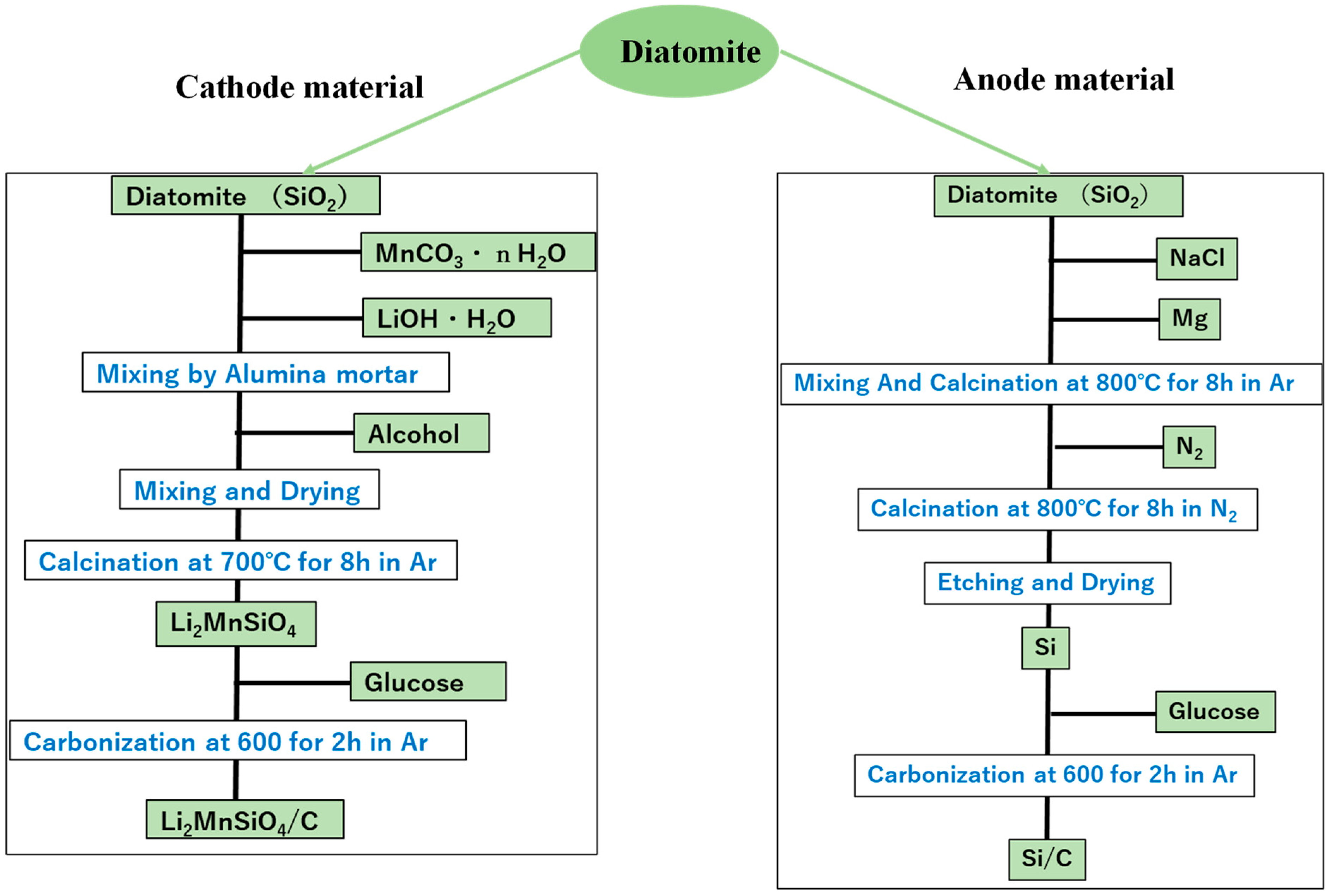
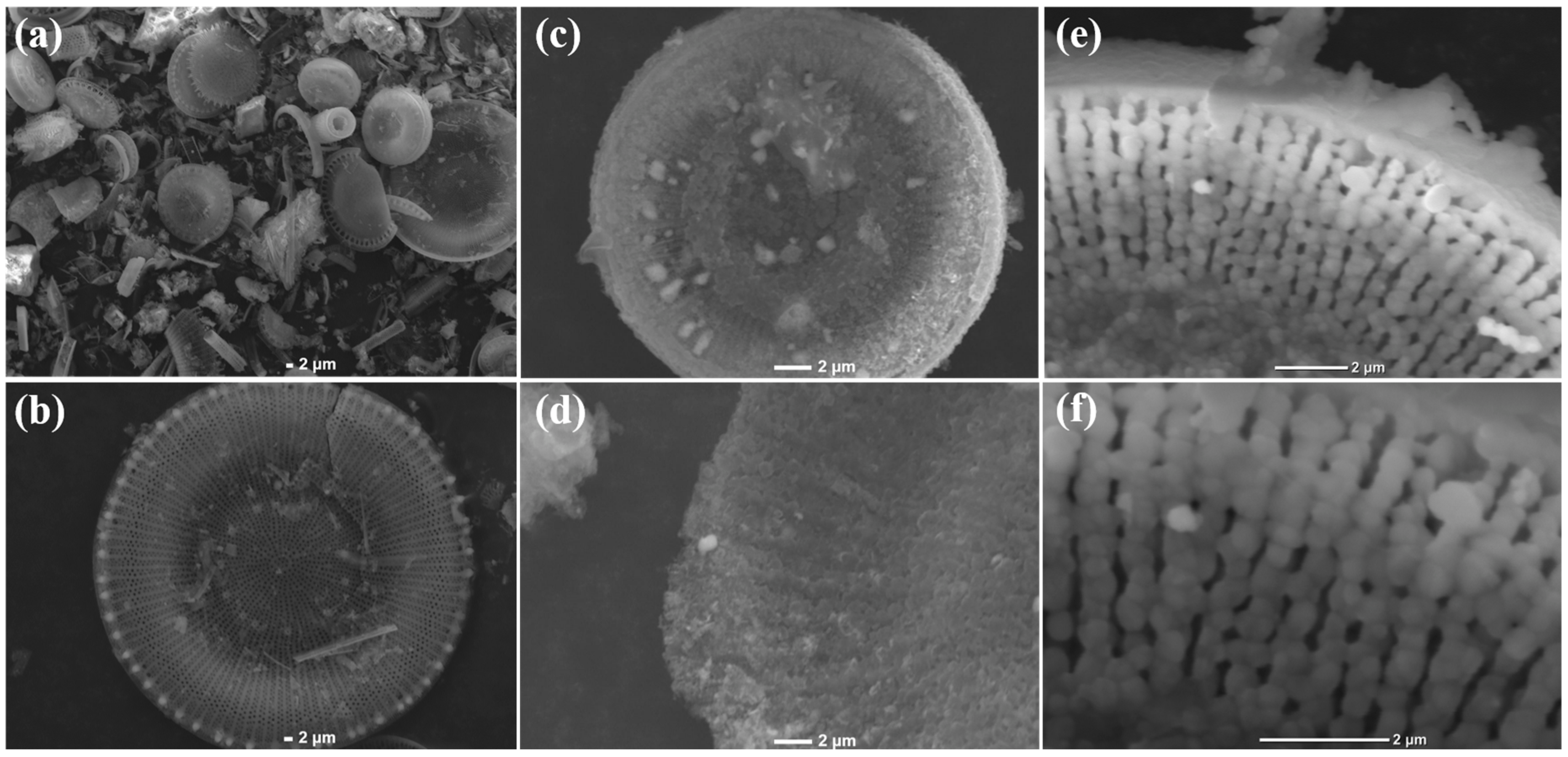


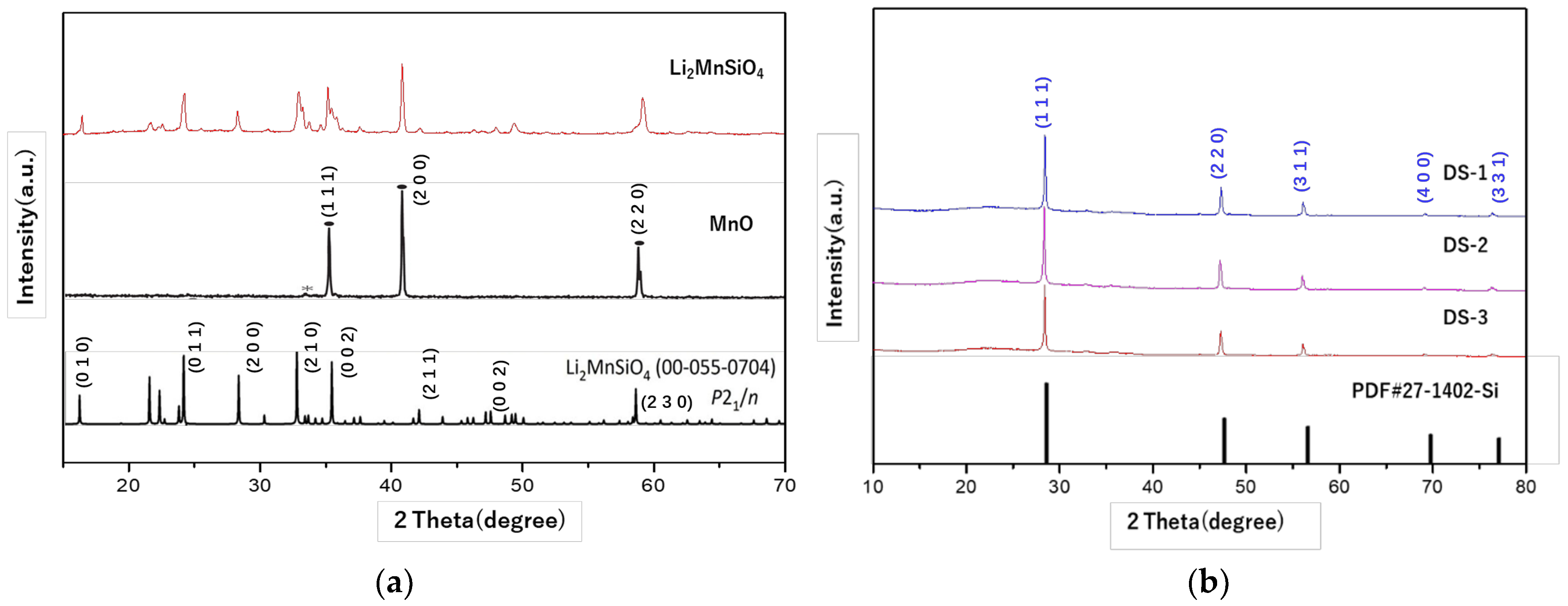
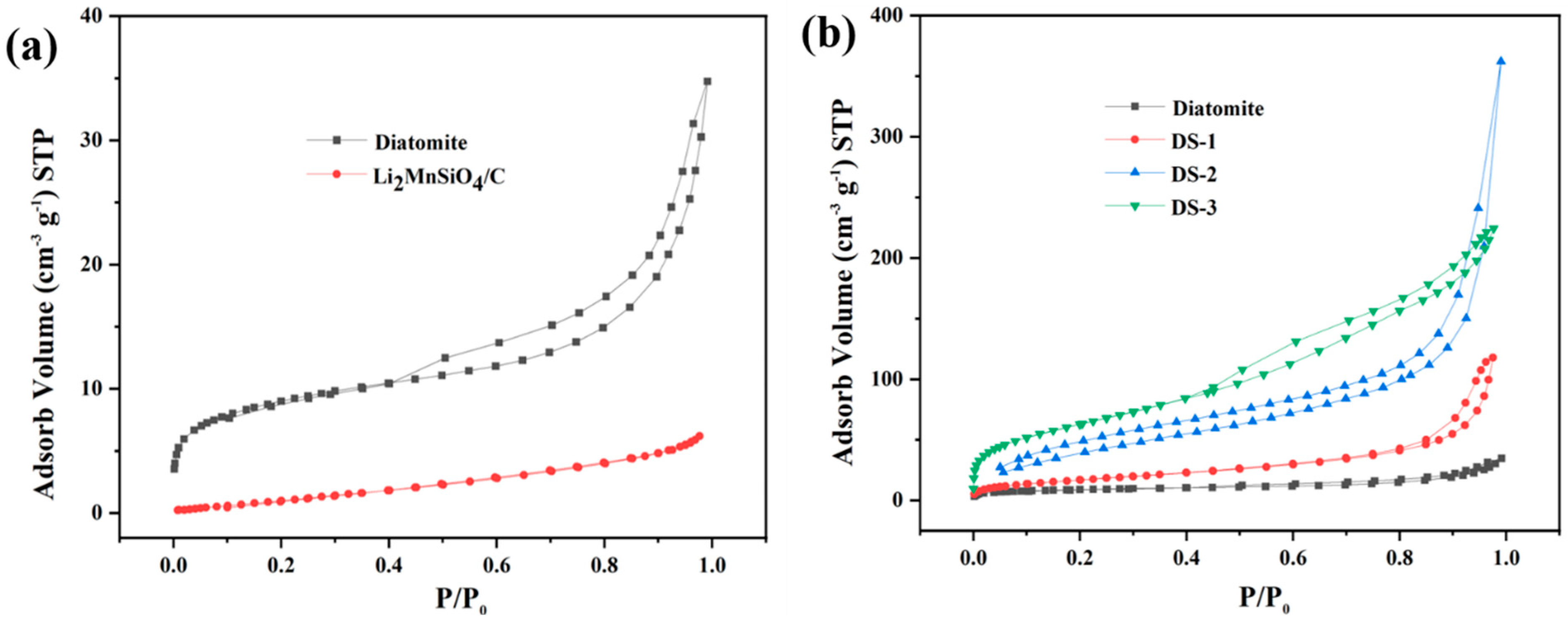
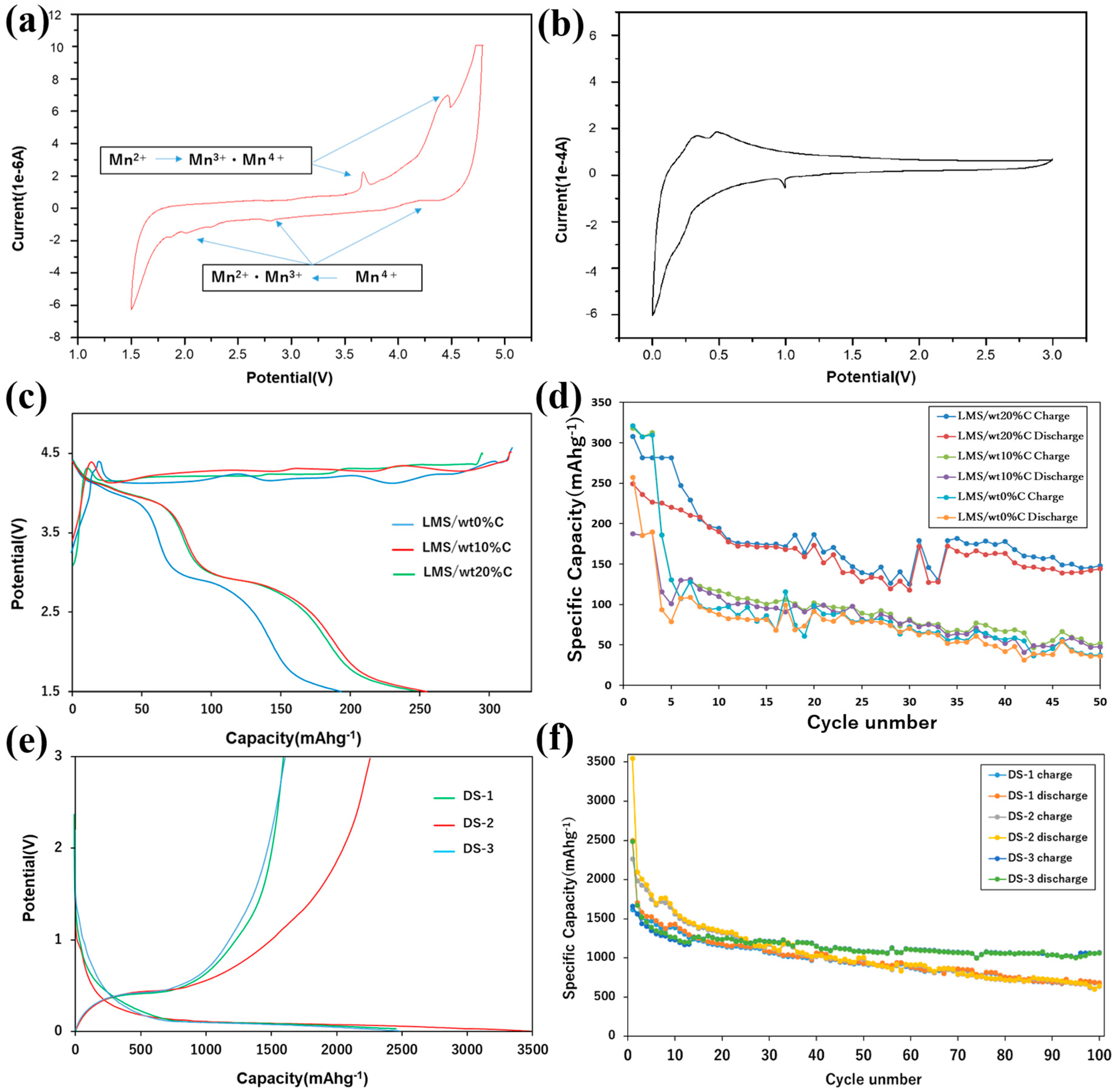
| Material | Specific Surface Area/m2 g−1 | Pore Volume/m3 g−1 | |
|---|---|---|---|
| Precursor | Diatomite | 32.6 | 0.05 |
| Cathode | Li2MnSiO4/C | 6.4 | 0.01 |
| Anode | DS–1 | 137.6 | 0.18 |
| DS–2 | 160.6 | 0.56 | |
| DS–3 | 253.0 | 1.07 |
Disclaimer/Publisher’s Note: The statements, opinions and data contained in all publications are solely those of the individual author(s) and contributor(s) and not of MDPI and/or the editor(s). MDPI and/or the editor(s) disclaim responsibility for any injury to people or property resulting from any ideas, methods, instructions or products referred to in the content. |
© 2023 by the authors. Licensee MDPI, Basel, Switzerland. This article is an open access article distributed under the terms and conditions of the Creative Commons Attribution (CC BY) license (https://creativecommons.org/licenses/by/4.0/).
Share and Cite
Chen, Y.; Jiang, B.; Zhao, Y.; Liu, H.; Ma, T. Diatomite and Glucose Bioresources Jointly Synthesizing Anode/Cathode Materials for Lithium-Ion Batteries. Coatings 2023, 13, 146. https://doi.org/10.3390/coatings13010146
Chen Y, Jiang B, Zhao Y, Liu H, Ma T. Diatomite and Glucose Bioresources Jointly Synthesizing Anode/Cathode Materials for Lithium-Ion Batteries. Coatings. 2023; 13(1):146. https://doi.org/10.3390/coatings13010146
Chicago/Turabian StyleChen, Yun, Bo Jiang, Yue Zhao, Hongbin Liu, and Tingli Ma. 2023. "Diatomite and Glucose Bioresources Jointly Synthesizing Anode/Cathode Materials for Lithium-Ion Batteries" Coatings 13, no. 1: 146. https://doi.org/10.3390/coatings13010146
APA StyleChen, Y., Jiang, B., Zhao, Y., Liu, H., & Ma, T. (2023). Diatomite and Glucose Bioresources Jointly Synthesizing Anode/Cathode Materials for Lithium-Ion Batteries. Coatings, 13(1), 146. https://doi.org/10.3390/coatings13010146






